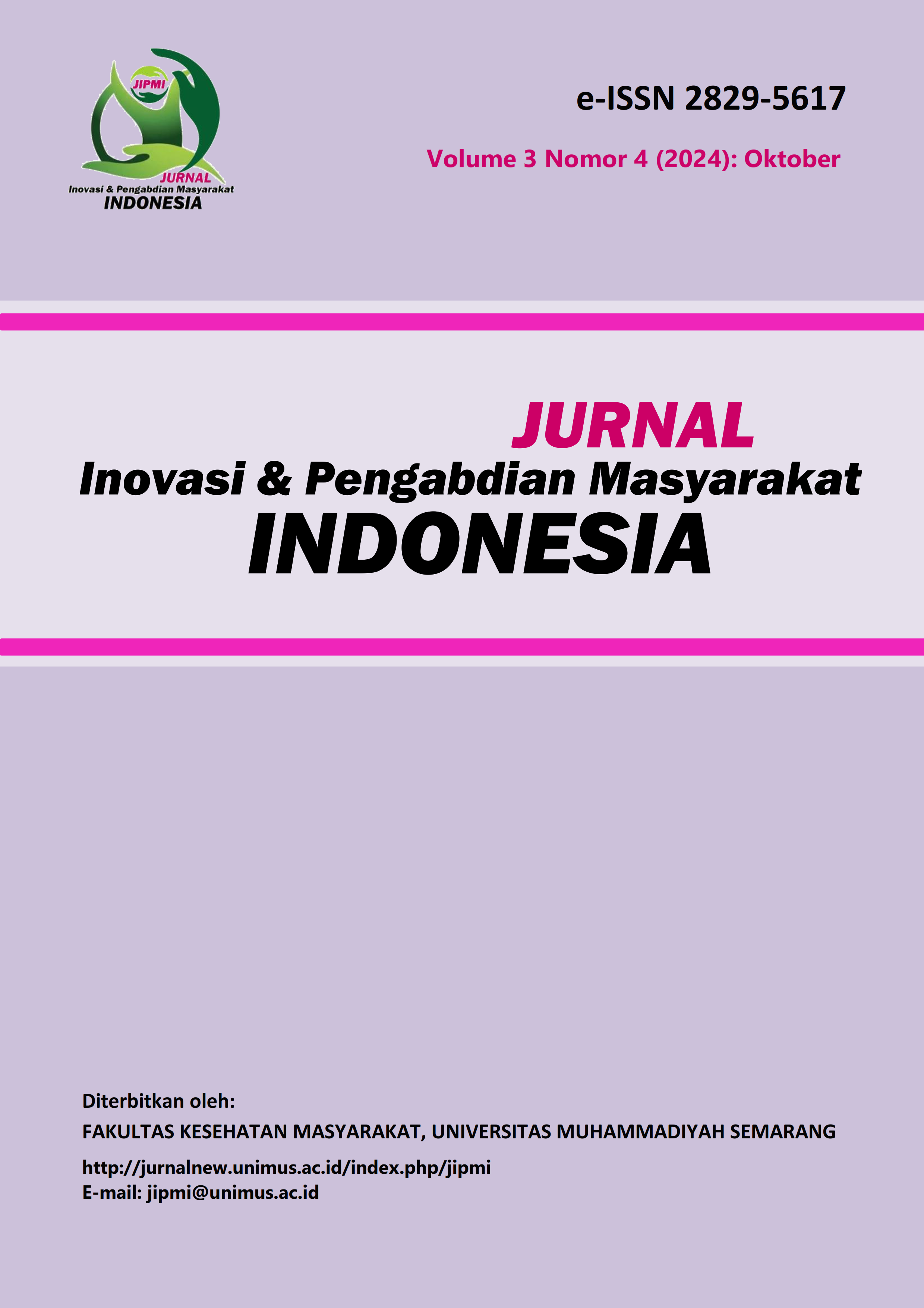Bersih-bersih Telinga Anak Sekolah Dalam Rangka Peringatan Hari Pendengaran Dunia 2024
DOI:
https://doi.org/10.26714/jipmi.v3i4.414Kata Kunci:
gangguan pendengaran, ketulian, membersihkan telinga, serumenAbstrak
Latar belakang: Menurut World Health Organization (WHO) gangguan pendengaran pada anak-anak di negara-negara berkembang, 60% disebabkan oleh kurangnya tindakan pencegahan. Hal tersebut berdampak pada pemahaman bicara, bahasa dan perkembangan sosial, yang akan mempengaruhi pencapaian akademik seperti kesulitan membaca, ejaan yang buruk, dan keterampilan menulis. Serumen impaksi berhubungan dengan kejadian gangguan pendengaran. Tujuan: Kegiatan ini bertujuan sebagai upaya preventif untuk menurunkan angka gangguan pendengaran pada anak usia sekolah. Metode: Sasaran kegiatan ini adalah siswa SD Muhammadiyah 08 kelas 3, sebanyak 66 siswa. Seluruh peserta dilakukan pemeriksaan THT secara umum untuk menilai kesehatan telinga. Apabila didapatkan adanya kotoran teinga, maka dilanjutkan dengan tindakan mengambil serumen dengan menggunakan aplikator dengan kapas, serumen spoon ataupun serumen hook serta metode irigasi. Hasil: Berdasarkan hasil pemeriksaan sebagian besar peserta adalah laki -laki 37 orang (56%), serta berdasarkan kebersihan telinganya mayoritas terdapat serumen dengan konsistensi lunak maupun keras, sebanyak 46 orang (70%). Kesimpulan: Mayoritas peserta dilakukan tindakan ekstraksi serumen. Masalah yang dijumpai pada kegiatan ini adalah serumen obsturans.
Kata kunci: gangguan pendengaran, ketulian, membersihkan telinga, serumen
______________________________________________________________________
Abstract
Background: According to the World Health Organization (WHO), 60% of hearing loss in children in developing countries is caused by a lack of preventive measures.It has an impact on speech understanding, language and social development, which will affect academic achievement such as reading difficulties, poor spelling and writing skills.Impacted cerumen is associated with hearing loss. Objective: This activity aims to be a preventive measure to reduce the rate of hearing loss in school-aged children. Method: The target of this activity is SD Muhammadiyah 08 grade 3 students, totaling 66 students. All participants underwent a general ENT examination to assess ear health. If ear discharge is found, then proceed with the action of collecting cerumen using a cotton applicator, cerumen spoon or cerumen hook as well as the irrigation method. Result: Based on the results of the examination, most of the participants were men, 37 people (56%), and based on the cleanliness of their ears, the majority had cerumen with a soft or hard consistency, as many as 46 people (70%). Conclusion: The majority of participants underwent cerumen extraction procedures. The problem encountered in this activity was cerumen obsturans.
Keywords: cerumen, deafness, ear cleaning, hearing disorder
Referensi
Iselin Ertzgaard S, Kristin N, Sofie T, et al. Prevalence of hearing impairment among primary school children in the Kilimanjaro region within Tanzania. Int J Pediatr Otorhinolaryngol; 130. Epub ahead of print 1 March 2020. DOI: https://doi.org/10.1016/j.ijporl.2019.109797.
Butler I. Identification and management of childhood hearing loss Most cases of hearing loss in children are not associated with syndromes. 2012.
Desalew A, Feto Gelano T, Semahegn A, et al. Childhood hearing impairment and its associated factors in sub-Saharan Africa in the 21st century: A systematic review and meta-analysis. SAGE Open Medicine; 8. Epub ahead of print 2020. DOI: https://doi.org/10.1177/2050312120919240.
Swain S, Sahu M, Debta P, et al. Antimicrobial properties of human cerumen. Apollo Medicine 2018; 15: 197.
Meyer F, Preuß R, Angelow A, et al. Cerumen Impaction Removal in General Practices: A Comparison of Approved Standard Products. J Prim Care Community Health; 11. Epub ahead of print 2020. DOI: https://doi.org/10.1177/2150132720973829.
Rodríguez R, Curado M, Pastor R, et al. Mechanism Cleaning of the Ear Canal. Inventions; 7. Epub ahead of print 1 March 2022. DOI: https://doi.org/10.3390/inventions7010020.
Subha ST, Corl M, alan Raman R, et al. Role of impacted cerumen in hearing loss, www.interacoustics.com.
Mccarter DF, Courtney AU, Pollart SM. Cerumen Impaction, www.aafp.org/afp. (2007).
Shope TR, Chen CP, Liu H, et al. Randomized trial of irrigation and curetting for cerumen removal in young children. Front Pediatr; 7. Epub ahead of print 2019. DOI: https://doi.org/10.3389/fped.2019.00216.
Guest JF, Greener MJ, Robinson AC, et al. Impacted cerumen: Composition, production, epidemiology and management. QJM: An International Journal of Medicine 2004; 97: 477–488.
Penelitian L, Pratiwi Rahardjo S, Iriani Djufri N, et al. Perbandingan efektivitas beberapa pelarut terhadap serumen obturans secara in vitro di Makassar. 2012.
Khan NB, Thaver S, Govender SM. Self-ear cleaning practices and the associated risk of ear injuries and ear-related symptoms in a group of university students. J Public Health Afr 2017; 8: 149–154.
Widuri A. The Influence of Chewing Habits on the Degree of Impacted Cerumen. Mutiara Medika: Jurnal Kedokteran dan Kesehatan 2021; 21: 1–6.
Karlsmose B, Lauritzen T, Engberg M, et al. A randomised controlled trial of screening for adult hearing loss during preventive health checks. 2001.
Mabenda SB, Bunabe G, Gilyoma JM, et al. Prevalence of cerumen impaction and associated factors among primary school children in Mwanza City, Tanzania. Tanzan J Health Res 2019; 21: 1–9.
Unduhan
Diterbitkan
Cara Mengutip
Terbitan
Bagian
Lisensi
Hak Cipta (c) 2024 JURNAL INOVASI DAN PENGABDIAN MASYARAKAT INDONESIA

Artikel ini berlisensi Creative Commons Attribution-NonCommercial 4.0 International License.
















